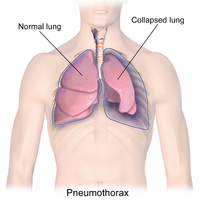
Photo from wikipedia
Summary Background A systematic review and meta-analysis of all available publications was performed to evaluate the diagnostic accuracy of percutaneous transthoracic needle biopsy (PTNB) using a C-Arm Cone-Beam CT (CBCT)… Click to show full abstract
Summary Background A systematic review and meta-analysis of all available publications was performed to evaluate the diagnostic accuracy of percutaneous transthoracic needle biopsy (PTNB) using a C-Arm Cone-Beam CT (CBCT) system in patients with lung nodules. Material/Methods Thedatabases of PUBMED, OVID, EBSCO, EMBASE, and China National Knowledge Infrastructure (CNKI) were systematically searched for relevant original articles on the diagnostic accuracy of CBCT-guided PTNB for the diagnosis of nodules in the lungs. Diagnostic indices including sensitivity, specificity, positive likelihood ratio (PLR), negative likelihood ratio (NLR), diagnostic odds ratio (DOR) and diagnostic score (DS) were calculated. Moreover,summary receiver operating characteristic curves (SROC) were constructed with Stata (version 13.0), Rev Man (version 5.3), and Meta-disc (version 1.4) software. Other clinical indices such as incidence of complications were also recorded. Results Eight studies met the inclusion and exclusion criteria for the meta-analysis. The pooled sensitivity, specificity, PLR, NLR, DOR, DS, and SROC with 95% confidence intervals were 0.96 (0.93–0.98), 1.00 (0.91–1.00), 711.15 (9.48–53325.89), 0.04 (0.02–0.07), 16585.29 (284.88–9.7e+05), 9.72 (5.65–13.78), and 0.99 (0.97–0.99), respectively. The incidence of pneumothorax and hemorrhage was 10–29.27% and 1.22–47.25%, respectively. Conclusions CBCT-guided PTNB has an acceptable rate of complications and is associated with a reasonable radiation exposure. Moreover, it is a highly accurate and safe technique for the diagnosis of lung nodules and can be recommended to be used in routine clinical practice.
Journal Title: Polish Journal of Radiology
Year Published: 2017
Link to full text (if available)
Share on Social Media: Sign Up to like & get
recommendations!